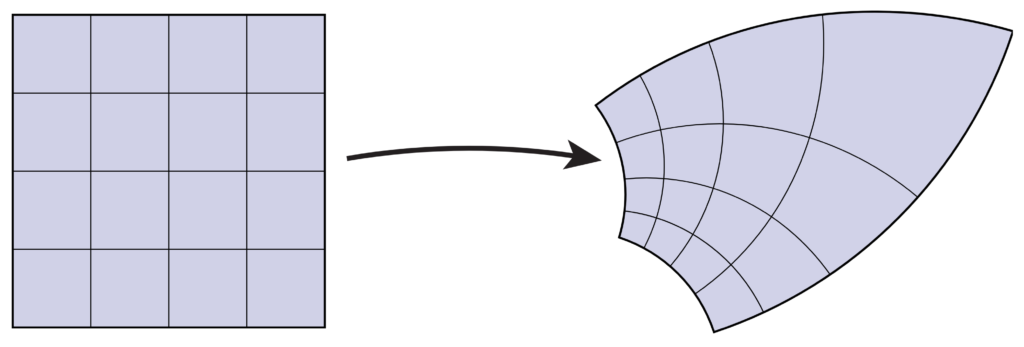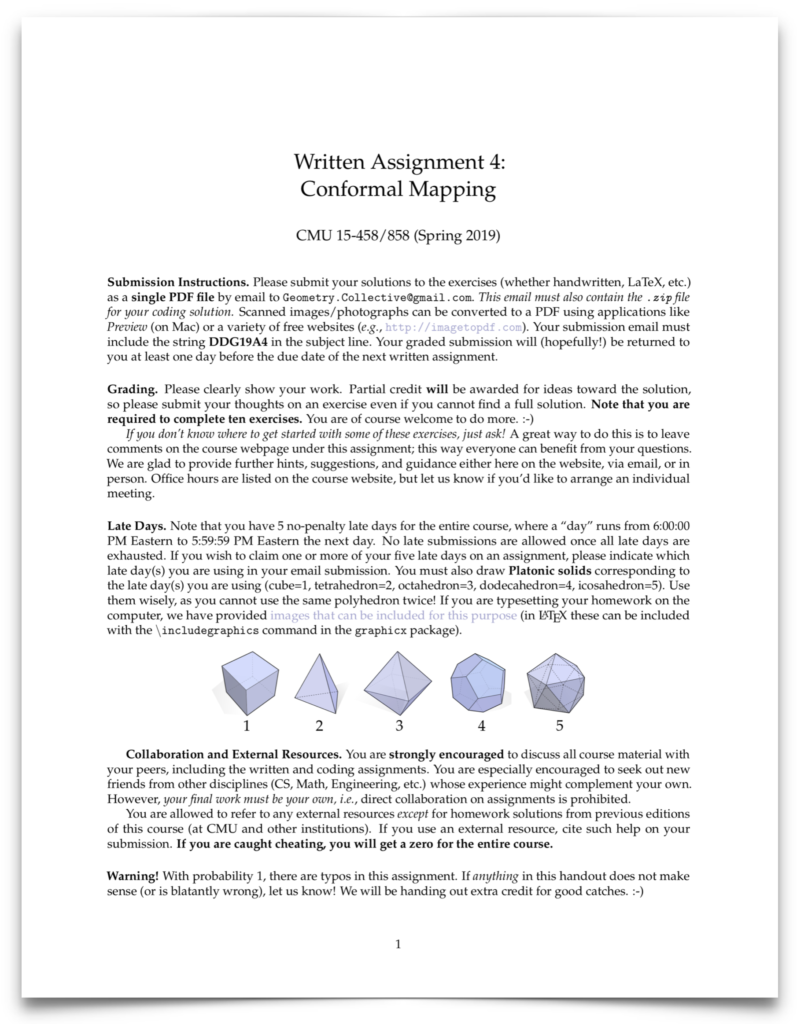
The written part of your next assignment, on conformal surface flattening, is now available below. Conformal flattening is important for (among other things) making the connection between processing of 3D surfaces, and existing fast algorithms for 2D image processing. You’ll have the opportunity to implement one of these algorithms in the coding part of the assignment.


Hi,
tl;dr: is there some relationship between the conjugate of a map $z$ that allows us to say something about $d \overline{z}$ and $dz$? How does the cross product relate to the wedge product or the differential $d$ in these cases?
I’m a little confused on how to get started for Exercise 7.7—it seems like we want to be evaluating some integral over the region $z(M)$, and looking at the slides for smooth surfaces (http://brickisland.net/DDGSpring2019/wp-content/uploads/2019/03/DDG_458_SP19_Lecture12_SmoothSurfaces.pdf) under vector area, it looks like we want to be looking at $\int_{z(M)} dz \wedge dz (X, \mathcal{J}X)$, but what I don’t understand is how we either introduce the cross product (since I thought $da \wedge db (X, Y) = da(X) db(Y) – da(Y)db(X)$) or get the conjugate $d\overline{z}$ into the expression. It seems like it might be related to how the conjugate can be seen as a rotation by 180 degrees in the complex plane and how $\mathcal{J}$ is the complex structure corresponding to a 90 degree rotation. It also seems like the notes on page 85 of 5.1 Vector Area sort of assume that $A = \int_P dx \wedge dy$, which looks a lot like the expression for area we’re trying to show.
Exercise 7.8 also has me a bit stumped, I started by expanding the right hand side and got as far as
$$E_D(z) – \mathcal{A}(z) = 1/2 \langle \langle \Delta z, z\rangle \rangle + \frac{i}{2}\int_M d\overline{z} \wedge dz $$
$$ = 1/2 \langle \langle d z, d z\rangle \rangle + \frac{i}{2}\int_M d\overline{z} \wedge dz $$
$$ = \frac{1}{2}\int_M \star d\overline{z} \wedge dz + i d\overline{z} \wedge dz $$
but found myself unable to really work with the conjugates or do anything with the two similar wedge-products—it seems like we should be going for an expression like $\langle \langle \star d \overline{z} – i dz\rangle \rangle$ to be able to turn it into a magnitude. Should I be applying these to a pair of basis 1-vectors $(X, \mathcal{J}X)$?
For 7.7, you should look at exercise 7.3 to relate cross products and complex multiplication.
For 7.8, you should try expanding out the definition of $E_C$ and relating what you get to the expression you’ve worked out for $E_D – \mathcal A$.
For 7.7 I followed the vector area slide but wasn’t quite able to get the two sides of the expression we wanted to prove to meet—I was also wondering why in this case we use the cross product $da \wedge db (X, \mathcal{J}X) = da (X) \times db(\mathcal{J}X) – da (\mathcal{J}X) \times db (X)$ instead of just $da \wedge db (X, \mathcal{J}X) = da (X) db(\mathcal{J}X) – da (\mathcal{J}X) db (X)$. I got
$$\mathcal{A}(z) = \int_M dz \wedge dz (X, \mathcal{J}X) = \int_M dz(X) \times dz (\mathcal{J}X) – dz(\mathcal{J}X) \times dz(X) $$
$$= \int_M 2 dz(X) \times dz (\mathcal{J}X) = \int_M 2(d\overline{z}(X) dz(\mathcal{J}X) – dz(X) dz(\mathcal{J}X))$$
Also, I just wanted to confirm that the integral is over $M$ an dnot $z(M)$ since we have the differential of $z$ inside the integral, which means that we integrate the pushed-forward forms $z$ in the domain $M$, giving us their area in the image $z(M)$? Or do I have that backwards.
For 7.8 I was able to get the conjugate into the expression
$$E_C = … = \frac{1}{4}\int_M -d \overline{z} \wedge \star dz + i d \overline{z} \wedge dz – i \star d \overline{z} \wedge \star dz – \star d \overline{z} \wedge dz$$
which shares one term in common with the right side (above) and has the negative of the other term, but I don’t see how we can get rid of the other terms, since the “boundary trick” of $d\overline{z} \wedge dz = d(\overline{z} \wedge dz)$ only works on the $d \overline{z} \wedge dz$ term, not the terms with the stars in them. I’ve also tried simplifying that by applying double stars to some terms to rewrite the four terms there as inner products, but I soon arrive at $\frac{-i}{4}(\overline{\langle \langle \star dz, dz, \rangle \rangle} \langle \langle \star dz, dz \rangle \rangle)$ and 0 shortly afterwards.
I’m sure I’m missing some rule that would allow me to make sense of those four terms.
For 7.7,
the wedge product we use is $\alpha \wedge \beta(X, Y) = \overline \alpha(X)\beta(Y) – \overline\alpha(Y)\beta(X)$. Sorry, I should have clarified that earlier.(See next comment)The integral in 7.7 is over $M$. $dz$ is a complex-valued differential form on $M$, so $d\overline z \wedge dz$ is a complex-valued 2-form on $M$.
The expression you wrote for $E_C$ doesn’t look quite right to me. Maybe you’re missing the conjugation in your wedge product?
I misspoke yesterday – the wedge product really is $\alpha \wedge \beta(X, Y) = \alpha(X)\beta(Y) – \alpha(Y)\beta(X)$. The difference is that our inner product is not $\langle\langle \alpha, \beta \rangle \rangle = \int \overline \star \alpha \wedge \beta$.
Hello,
I am kind of confused by the discussions above. When doing wedge product ?∧?(?,?) which inner product should we use? Should we just simply multiply these two complex numbers or should we use cross product?
Many thanks!
You should just multiply the complex numbers. But Exercise 7.3 tells you how multiplication of complex numbers is related to cross products (and thus areas).
That’s what I thought, thank you!
for exercise 7.14, what does $min_x~x^TAx$ exactly mean? I assume that $x$ is taken over the space of linear functions. But $x^TAx$ is a function, not a value. So what do we define its minimum to be? Also, does the constraint $||x||=1$ mean that $||x(v)||=1$ for all $v$ with $||v||=1$?
In exercise 7.14 $x$ is just a vector in $\mathbb R^n$. So $x^TAx$ is a scalar value, and $\|x\|$ is the regular Euclidean norm of $x$.
Do we have to prove that a symmetric matrix with n distinct eigenvalues has an orthonormal eigenbasis? Or is that just common knowledge.
You can say it’s common knowledge